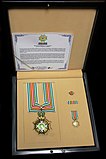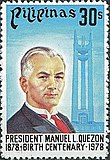
Manuel L. Quezon
Manuel Luis Quezon y Molina GCGH KGCR (UK: /ˈkeɪzɒn/, US: /ˈkeɪsɒn, -sɔːn, -soʊn/, Tagalog: [maˈnwel ˈluwis ˈkɛson], Spanish: [maˈnwel ˈlwis ˈkeson i moˈlina]; 19 August 1878 – 1 August 1944), also known by his initials MLQ, was a Filipino lawyer, statesman, soldier, and politician who was president of the Commonwealth of the Philippines from 1935 until his death in 1944. He was the first Filipino to head a government of the entire Philippines and is considered the second president of the Philippines after Emilio Aguinaldo (1899–1901), whom Quezon defeated in the 1935 presidential election.
In this Spanish name, the first or paternal surname is Quezon and the second or maternal family name is Molina.
Manuel L. Quezon
Emilio Aguinaldo
Frank Murphy (as Governor-General)
Himself
- Gil Montilla (National Assembly Speaker)
- Manuel Roxas (Senate President)
Vicente Fragante
Position established
Alberto Barreto
District established
Filemon Pérez
Ricardo G. Parás
Alfredo Castro
19 August 1878
Baler, El Príncipe, Nueva Écija, Captaincy General of the Philippines (now Baler, Aurora, Philippines)
1 August 1944 (aged 65)
Saranac Lake, New York, U.S.
- Arlington National Cemetery, Arlington County, Virginia (1944–1946)
- Manila North Cemetery, Santa Cruz, Manila, Philippines (1946–1979)
- Quezon Memorial Shrine, Quezon City, Philippines (since 1 August 1979)
4
Manuel L. Quezon III (grandson)
- 1899–1900
- 1941–1944
During his presidency, Quezon tackled the problem of landless peasants. Other major decisions included the reorganization of the islands' military defense, approval of a recommendation for government reorganization, the promotion of settlement and development in Mindanao, dealing with the foreign stranglehold on Philippine trade and commerce, proposals for land reform, and opposing graft and corruption within the government. He established a government in exile in the U.S. with the outbreak of World War II and the threat of Japanese invasion. Scholars have described Quezon's leadership as a "de facto dictatorship"[1] and described him as "the first Filipino politician to integrate all levels of politics into a synergy of power" after removing his term limits as president and turning the Senate into an extension of the executive through constitutional amendments.[2]
Quezon died of tuberculosis in Saranac Lake, New York, during his exile. He was buried at Arlington National Cemetery until the end of World War II, when his remains were moved to Manila. and interred at Manila North Cemetery in 1946. His remains were finally transferred to his final resting place in 1979 inside the Quezon Memorial Circle.
In 2015, the Board of the International Raoul Wallenberg Foundation bestowed a posthumous Wallenberg Medal on Quezon and the people of the Philippines for reaching out to victims of the Holocaust from 1937 to 1941. President Benigno Aquino III and then-94-year-old Maria Zenaida Quezon Avanceña, the daughter of the former president, were informed of this recognition.
Presidential styles of
Manuel L. Quezon
Quezon had developed tuberculosis and spent his last years in hospitals, including a Miami Beach Army hospital in April 1944.[42] That summer, he was at a cure cottage in Saranac Lake, New York. Quezon died there at 10:05 a.m. ET on 1 August 1944, at age 65. His remains were initially buried in Arlington National Cemetery, but his body was brought by former Governor-General and High Commissioner Frank Murphy aboard the USS Princeton and re-interred in the Manila North Cemetery on 17 July 1946.[43] Those were then moved to a miniature copy of Napoleon's tomb[44] at the Quezon Memorial Shrine in Quezon City, on 1 August 1979.[45]
The Foreign Orders, Medals and Decorations of President Manuel L. Quezon:
Quezon City, the province of Quezon, Quezon Bridge in Manila, Manuel L. Quezon University, and many streets are named after him. The Quezon Service Cross is the Philippines' highest honor. Quezon is memorialized on Philippine currency, appearing on the Philippine twenty-peso note and two commemorative 1936 one-peso coins: one with Frank Murphy and another with Franklin Delano Roosevelt.[51] Open Doors, a Holocaust memorial in Rishon LeZion, Israel, is a 7-metre-tall (23 ft) sculpture designed by Filipino artist Luis Lee Jr. It was erected in honor of Quezon and the Filipinos who saved over 1,200 Jews from Nazi Germany.[52][53]
Municipalities in six provinces are named after Quezon: Quezon, Bukidnon; Quezon, Isabela; Quezon, Nueva Ecija; Quezon, Nueva Vizcaya; Quezon, Palawan; and Quezon, Quezon. The Presidential Papers of Manuel L. Quezon was inscribed in the UNESCO Memory of the World Register in 2011.[54] Quezon Island is the most developed island in the Hundred Islands National Park.[55]
In popular culture[edit]
Quezon was played by Richard Gutierrez in the 2010 music video of the Philippine national anthem produced and aired by GMA Network.[56] Arnold Reyes played him in the musical MLQ: Ang Buhay ni Manuel Luis Quezon (2015).[57] Quezon was played by Benjamin Alves in the film, Heneral Luna (2015).[58] Alves and TJ Trinidad played him in the 2018 film Goyo: Ang Batang Heneral (2018),[59] and he was played by Raymond Bagatsing in the film Quezon's Game (2019).[60]
Speech recording[edit]
A sample of Quezon's voice is preserved in a recorded speech, "Message to My People", which he delivered in English and Spanish.[61] According to Manuel L. Quezon III, his grandfather's speech was recorded when he was President of the Senate "in the 1920s, when he was first diagnosed with tuberculosis and assumed he didn't have much longer to live."[62]







